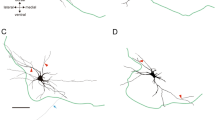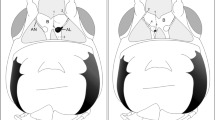Summary
A structure is described in the head ofDermestes maculatus, which probably controls the motion of the mandible as a muscle receptor: About 10 multipolar neurons send dendritic processes without any ciliary structure into the interior of the third mandibular muscle, musculus tentorio-mandibularis, where they periodically ramify in the levels of the Z-bands. The possibility is being discussed, that the dendritic terminations detect muscular activity by detecting the ionic changes associated with contraction.
Zusammenfassung
Im Kopf vonDermestes maculatus wird eine Struktur beschrieben, die wahrscheinlich als Muskelrezeptor die Bewegung der Mandibel kontrolliert: Etwa 10 multipolare Neurone senden Dendriten ohne ciliÄre Strukturen in das Innere des sehr dünnen dritten Mandibelmuskels, Musculus tentorio-mandibularis, wo sie sich periodisch jeweils im Niveau der Z-Scheiben verzweigen. Die Möglichkeit wird erwogen, da\ die Änderung im lonenmilieu bei der Kontraktion des Muskels als Reiz perzipiert wird.
Similar content being viewed by others
Literatur
Adam, H., Czihak, G.: Arbeitsmethoden der makroskopischen und mikroskopischen Anatomie. Stuttgart: Fischer 1964
Anwyl, R.: The structure and properties of an abdominal stretch receptor inRhodnius prolixus. J. Insect Physiol.18, 2143–2153 (1972)
Bodian, D., Bergman, R.A.: Muscle receptor organs of crayfish: Functional-anatomical correlations. Bull. J. Hopk. Hosp.110, 78–106 (1962)
Coillot, J.P., Boistel, J.: Localisation et description de lécepteurs a retirement au niveau de l'articulation tibio-fémorale de la patte sauteuse du criquet,Scbistocerca gregaria. J. Insect Physiol.14, 1661–1667 (1968)
Finlayson, L.H., Lowenstein, O.: A proprioceptor in the body musculature of lepidoptera. Nature176, 1031 (1955)
Finlayson, L.H., Lowenstein, O.: The structure and function of abdomial stretch receptors in insects. Proc. R. Soc. Lond. (B)148, 433–449 (1958)
Honomichl, K.: Beitrag zur Morphologie des Kopfes der Imago vonGyrinus substriatus Stephens, 1829 (Coleoptera, Insecta). Zool. Jb. Anat.94, 218–295 (1975)
Kéler, St. v.: Entomologisches Wörterbuch. Berlin: Akademie-Verlag 1963
Markl, H.: Ein neuer Proprioreceptor am Coxa-Trochanter-Gelenk der Honigbiene. Nature52, 460 (1965)
Matsuda, R.: Morphology and evolution of the insect head. Mem. Amer. Ent. Inst.4 (1965)
Moulins, M.: Etude anatomique de l'hypopharynx deForficula auricularia L. (Insectes, Dermaptères): Téguments, musculature, organes sensoriels et innervations. Interprétation morphologique. Zool. Jb. Anat.86, 1–27 (1969)
Moulins, M.: Récepteurs de tension de la région de la bouche chezBlaberus craniifer Burmeister (Dictyoptera: Blaberidae). Int. J. Insect. Morphol. & Embryol.3 (2), 171–192 (1974)
Nadol, J.B., de Lorenzo, A.J.D.: Observations on the abdominal stretch receptor and the fine structure of associated axo-dendritic synapses and neuromuscular junctions inHomarus. J. comp. Neurol.132, 419–444 (1968)
Nadol, J.B., de Lorenzo, A.J.D.: Observations on the organization of the dendritic processes and receptor terminations in the abdominal muscle receptor organ ofHomarus. J. comp. Neurol.137, 19–58 (1969)
Osborne, M.P.: An electron microscope study of an abdominal stretch receptor of the cockroach. J. Insect Physiol.9, 237–245 (1963)
Osborne, M.P., Finlayson, L.H.: The structure and topography of stretch receptors in representatives of seven orders of insects. Quart. J. micr. Sci.103, 227–242 (1962)
Osborne, M.P., Finlayson, L.H.: An electron microscope study of the stretch receptor ofAntheraea pemyi (Lepidoptera, Saturnidae). J. Insect Physiol.11, 703–710 (1965)
Sinoir, Y.: L'ultrastructure des organes sensoriels des insectes. Ann. Zool. Ecol. anim.1, 339–356 (1969)
Slifer, E.H., Finlayson, L.H.: Muscle receptor organs in grasshoppers and locusts (Orthoptera, Acrididae). Quart. J. micr. Sci.97, 617–620 (1956)
Whitear, M.: The fine structure of crustacean proprioceptors. II. The thoracico-coxal organs inCarcinus, Pagurus andAstacus. Phil. Trans. B,248, 437–456 (1965)
Wigglesworth, V.B.: The nutrition of the central nervous system in the cockroach,Periplaneta americana L. J. exp. Biol.37, 500–512 (1960
Author information
Authors and Affiliations
Additional information
Zur Terminologie: Die vorliegende Untersuchung befa\t sich mit einem Propriorezeptor, dessen Neurone keine ciliÄren Strukturen aufweisen. Für solche Rezeptoren hat sich in der Literatur der Terminus „Streckrezeptor“ eingebürgert (vgl. Sinoir, 1969), was schon im Hinblick auf eine Abgrenzung von den Chordotonalorganen, die ja auch LÄngenÄnderungen messen, nicht glücklich zu sein scheint. Die Bezeichnung „Muskelrezeptor“ lehnt sich an Whitear (1965) an. Für Rezeptoren ohne ciliÄre Strukturen, bei denen allein ein Bindegewebsstrang das reizvermittelnde Gewebe darstellt, verwende ich entsprechend den Terminus „Bindegewebsrezeptor“
Rights and permissions
About this article
Cite this article
Honomichl, K. Feinstruktur eines Muskelrezeptors im Kopf vonDermestes maculatus De Geer (Insecta, Coleoptera). Zoomorphologie 85, 59–71 (1976). https://doi.org/10.1007/BF00996065
Received:
Issue Date:
DOI: https://doi.org/10.1007/BF00996065




